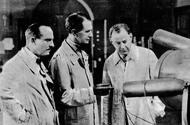Matthews (centre) first appeared in Autocar in 1912
It sounds like a con, but there was more to Harry Grindell Matthews’ machine than you might expect
Nothing about the 18 April 1924 issue of this magazine seems unusual.
On the cover, a colourful painting advertising Wolseley’s new Fourteen touring car. In the leader, a plea for drivers to take extra care in the Easter holiday traffic. In the road test, a new four-cylinder saloon from Vauxhall. The main feature, a preview of the British Empire Exhibition, to be held at a grand new purpose-built stadium in Wembley.
And in the news, the invention of the invisible death ray. Woah, hang on. What?!
“To stop an internal combustion engine without any visible agency is the uncanny achievement of at least one British electric engineer,” we reported.
“Clearly the value of this startling phenomenon lies solely in its use in wartime. Accordingly, Mr [Harry] Grindell Matthews can hardly be expected to disclose the means whereby he attains the striking result, and we are, therefore, limited to describing the demonstration.
“On a bench at one end of the inventor’s laboratory, there was placed an ‘Auto-wheel’, which consists of a small self-contained [ICE] with a high-tension magneto serving for ignition. This we were invited to examine thoroughly in order to assure ourselves that it was standard and that the magneto was not connected to anything but the sparking plug.
“Having satisfied ourselves of this, the engine was started and allowed to run up to a good speed. Mr Matthews then brought his invention into action at a distance of at least 45ft from the [ICE], which immediately ceased firing and rapidly slowed down as it lost its momentum. Just before it stopped, the power [was switched off] under his control, and with a slight spluttering from the carburettor, the [ICE] commenced to fire once more and rapidly picked up speed.
“To obtain this effect, electrical energy to the extent of 1kW was employed, and, broadly speaking, the invention may be described as the transmitting of electrical energy at extremely high tension by means of a projected ray which actually acts as a conductor. Of the nature of the ray, we can give no inkling.
“It is not visible, and we are informed that shielding the engine by means of insulating material, such as thick glass or metal, makes no difference to the control of the engine through the ignition.”
We considered: “Imagination is staggered at the future possibilities of such a potent weapon. It has been said that the next war will be almost entirely a war of machinery, but in the light of these experiments, it is questionable [if] there could be any future war.”
So just what was going on? It’s impossible to say. Matthews was far from alone in claiming such an invention, and you may suspect he was merely a clever, convincing con man.
But then he had invented, and would later invent, useful things. His name first appeared in Autocar in 1912, as he was testing a system of wireless message transmission between vehicles and aircraft, apparently with a range of up to 150 miles – which he would later demonstrate to the Queen.
During World War I, Matthews was given a £25k government contract to work on the remote control of ships. In the 1920s, he would help Warner Bros pioneer talking movies.
The big problem was that Matthews wouldn’t explain how his death ray worked and did not convince government officials with his demonstration of it.
His reaction was to run away to France to sell his invention – with the added drama of lawyers representing two of his investors dashing into the aerodrome as his plane was taking off, brandishing an injunction that forbade a sale.
He soon returned and allowed British Pathé to film his death ray igniting gunpowder – but nothing else. He even refused a £1000 Air Ministry offer to demonstrate it, despite reputedly being penniless.
Moving into a large bungalow surrounded by an electric fence in rural Gower, Wales (paid for, one suspects, by his new wife, a rich opera singer), he continued to work on suspect ‘inventions’, including a musical instrument that worked using rays of light, a sky projector, ‘aerial mines’ and a submarine detection system. Matthews died of a heart attack in 1941, aged 61.
Did Matthews really invent the death ray? Was he a genius, ahead of his time? Or was he a con man, a charlatan? His biographer believes the former, but we will probably never know the whole truth.







